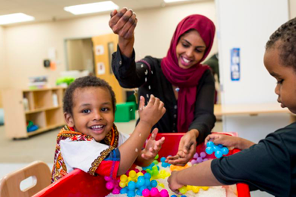Developing Our Sensory Systems Through Exploration


Before you read this, pause for a minute and notice all the sounds going on around you: appliances, voices, sounds from another room or outside. Now notice what you can see: The computer screen, dust, or dirt on the screen or catching in the sunlight, perhaps another person or pet is moving and you can just see them out of the corner of your eye. Think about what you feel on your skin: your clothing, the seat you are on, the air which may be a bit cold or a bit hot if you think about it.
Your body is constantly taking in a variety of information from your senses, but your brain filters out most of it until it is needed. Your brain is also using information from multiple senses as one system that works together. If you are sitting down now, you probably walked toward the chair, turned away from the chair as you prepared to sit, no longer looking at the chair and coordinated your muscles to lower yourself down to the height of the chair. This simple act required multiple senses working together to achieve an everyday task of sitting down.
Understanding Our Senses
Most people are aware of five senses: hearing, sight, smell, taste, and touch. In addition to these, there are three other senses: vestibular, which is the sense of balance, spatial orientation and gravity; proprioception, which is information from the muscles and joints that provides us with the position of our body parts and their relationship to each other and objects; and interoception, which is sense of the internal state of the body such as hunger.
Beginning in utero and continuing through early childhood, the body is constantly developing the ability to receive information from the senses, decide what is important and coordinate all of the information. Not surprisingly, this happens through exploration and play.
Engaging Our Senses Through Play
The following lists include a variety of activities and the senses that are associated with each of them. While all of us have our own sensory diet, there are times when certain sensory processing responses can be an indication that additional insight would be helpful. If you ever have questions related to your own child’s sensory processing, we’re here to help. Our CORE team can help navigate your request: 952-548-8700 or coreinfo@stdavidscenter.org.
Vestibular System: Receptors in the inner ear provide information about our body’s movement. They tell us if we are moving or staying still, the direction and speed of movement, and where we are moving in relation to the surrounding space.
Experiences:
Proprioception: Information from the muscles and joints provides us with the position of our body parts and their relationship to each other (general body awareness).
Experiences:
Tactile system: Information from the skin tells us about the texture/shape/size of objects, helps alert us to threats, define our body boundaries, and increases body awareness.
Experiences:
Auditory: The sounds we hear give us information about language and impact our ability to maintain an appropriate level of arousal/energy.
Experiences:
Visual System: Vision is considered the body’s top intelligence gatherer. Not only does it give us information about the world around us, it also plays an important role in attention and social interactions.
Experiences:
Taste and Smell: Specific tastes/scents impact our arousal level and organization of behavior.
Experiences:
Interoception: This sense helps a child notice how they feel inside often related to hunger, bowel/bladder, breath and heartbeat.
Experiences: